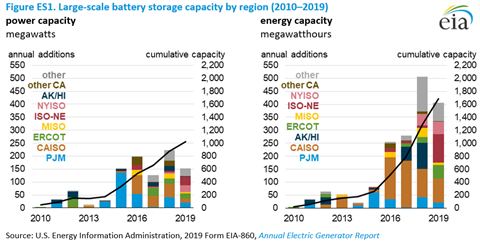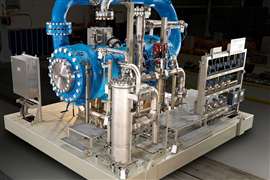Battery power capacity jumped 35% in 2020, EIA says
August 18, 2021
More than 10 000 MW expected to be added through 2023
U.S. battery power capacity reaching 1650 MW by the end of 2020—up 35% over 2019, ac. according to the U.S. Energy Information Agency’s (EIA) report, Battery Storage in the United States: An Update on Market Trends.
Indeed, U.S. battery power capacity has tripled in the last five years.
EIA expects the trend to continue; utilities have reported plans to install over 10 000 MW of additional large-scale battery power capacity from 2021 through 2023.
“Growth in U.S. battery systems is critical as the United States faces new hurdles to reliable electricity delivery,” said EIA Acting Administrator Steve Nalley. “Energy stored in batteries can react to second-to-second fluctuations in the electric grid, protecting grid power quality and improving the grid’s efficiency.”

Much of the recent increase in new storage capacity comes from battery energy systems co-located with or connected to solar projects.
“Battery systems can help store electricity generated from solar or other renewables so that electricity is available at times when demand is peaking, but generation from renewables is lower,” Nalley said.
Five states account for more than 70% of U.S. battery storage power capacity as of December 2020, with California alone accounting for 31% of the U.S. total (506 MW). Texas, Illinois, Massachusetts, and Hawaii each have more than 50 MW of power capacity.
More than 400 MW of small-scale total battery storage power capacity also existed in the United States as of 2019, with California accounting for 83% of the capacity. Small-scale batteries have a nameplate power capacity of 1 MW or less.
Power capacity measures the maximum amount of power a battery system can discharge in an instant. Large-scale batteries can also be measured by energy capacity—the amount of energy a battery system can store. U.S. battery system energy capacity also continued to increase, reaching 1688 megawatthours at the end of 2019, a 30% increase from 2018.
The costs of installing and operating large-scale battery storage systems in the United States have declined in recent years.
Average battery energy storage capital costs in 2019 were $589 per kilowatthour (kWh), and battery storage costs fell by 72% between 2015 and 2019, a 27% per year rate of decline.
These lower costs support more capacity to store energy at each storage facility, which can increase the duration that each battery system can last when operating at its maximum power.
Most large-scale battery energy storage systems we expect to come online in the United States over the next three years are to be built at power plants that also produce electricity from solar photovoltaics, a change in trend from recent years.
As of December 2020, the majority of U.S. large-scale battery storage systems were built as standalone facilities, meaning they were not located at sites that generate power from natural resources. Only 38% of the total capacity to generate power from large-scale battery storage sites was co-located with other generators: 30% was co-located specifically with generation from renewable resources, such as wind or solar PV, and 8% was co-located with fossil fuel generators.
We expect the relationship between solar energy and battery storage to change in the United States over the next three years because most planned upcoming projects will be co-located with generation, in particular with solar facilities. If all currently announced projects from 2021 to 2023 become operational, then the share of U.S. battery storage that is co-located with generation would increase from 30% to 60%.
MAGAZINE
NEWSLETTER

CONNECT WITH THE TEAM









